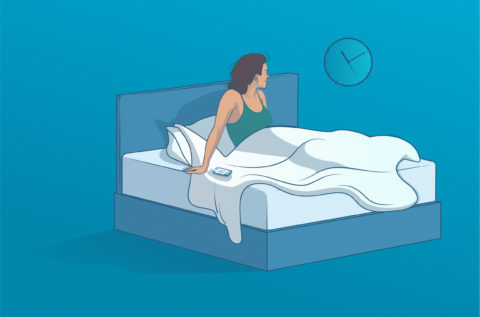Meditation is an ancient practice allowing us to better connect with our minds and bodies. At its core, meditation gives you methods to train your attention and achieve a heightened sense of awareness. It’s also used to help relax and calm your mind and body. While mindfulness has become a popular form of meditation, sleep meditation is also gaining traction for its perceived positive impact on sleep quality and helping the onset of sleep.
Sleep meditation is described as a version of mindfulness with the direct purpose of priming the body for sleep. It is usually practiced in bed before going to sleep. Join us as we explore the most popular forms of meditation before bed and their impact.
Try Sleep Cycle’s guided sleep meditation for free
How to Meditate in Bed: Top 6 Techniques
Sleep meditation offers flexibility in terms of duration, allowing you to adapt it to your personal needs, whether you prefer a longer or shorter session. You can engage in this practice either independently or with the assistance of our guided meditations or sleep stories.
These resources are available in our Sleep Aid feature as well as within the Sleep Program titled “Relax the mind.” By incorporating these tools, you can enhance your relaxation experience and promote a more peaceful mind and restful sleep.
1. Breathing
This is one of the key pillars of meditation and forms the basis of most meditation practices. One technique is box breathing, a rhythmic pattern of breath control, where inhalation, breath retention, and exhalation occur at a deliberate count of four. Box breathing, with its balanced and intentional approach, proves especially beneficial in alleviating anxiety and promoting a sense of calm.
In fact, within various sleep meditation audio guides, you will frequently encounter dedicated segments that center entirely on the practice of conscious breathing. These segments emphasize the significance of focusing on the breath as a means to anchor the mind, relax the body, and induce a state of tranquility conducive to deep and restorative sleep.
By incorporating intentional breathwork into your sleep meditation routine, you can harness the power of controlled respiration to promote relaxation, reduce stress, and enhance your overall sleep experience.
2. Visualization
Visualization serves as a powerful technique for guiding and influencing the mind by harnessing the power of imagery and colors that resonate with one’s mood. By engaging in this practice, individuals can create a mental landscape that evokes feelings of safety, tranquility, and positivity. A common approach involves visualizing a personal sanctuary, often referred to as a “happy place” or a space that instills a sense of security and serenity.
During visualization meditation, one pays close attention to the sensory details such as sights, sounds, smells, and even tactile sensations. The intention is to immerse oneself fully in this mental representation, allowing the mind and body to embrace a state of relaxation and ease. Engaging in visualization meditation before sleep cultivates a sense of tranquility and allows individuals to release any lingering tension or anxiety. By creating a serene mental atmosphere through imagery and colors, one can establish an inviting and calming environment that encourages the body and mind to embrace a restful sleep state.
3. Body awareness
This technique focuses on quietly scanning the body, concentrating on the thoughts and sensations emitted from each part of the body. This can also effectively be combined with:
- Progressive Muscle Relaxation (PMR), a technique commonly employed in sleep meditation. The exercise involves tensing and releasing muscles, progressing throughout the body, with afocus on the release of the muscle as the relaxation phase.
Body scan: involves directing your attention to individual body parts, aiming to heighten your awareness of the physical sensations experienced, such as tension and discomfort. By concentrating on each area, this practice encourages relaxation, ultimately assisting in achieving better sleep.
4. Stories and sounds
The availability of sleep-related content continues to expand, encompassing a wide array of stories, soothing sounds, and calming music that serve as aids for achieving a restful sleep. For some, sleep stories and sleep sounds often serve as their initial introduction to the concept of sleep meditation. These engaging narratives and gentle auditory compositions play a significant role in creating a serene atmosphere conducive to falling asleep.
By immersing oneself in these captivating narratives and soothing sounds, individuals can establish a soothing bedtime routine that fosters relaxation, easing their minds and bodies into a state of tranquility, ultimately facilitating a peaceful and rejuvenating sleep experience.
5. Gratefulness
Also referred to as compassion meditation, involves directing your attention towards positive and affectionate elements of your life, as well as cultivating a sense of gratitude. By integrating the practice of gratefulness into your sleep meditation routine, you can establish a foundation for improved sleep quality.
This approach encourages you to concentrate on fostering a mindset that keeps grievances and negativity at bay, allowing you to embrace feelings of appreciation and contentment instead. By nurturing an attitude of gratitude, you create a mental and emotional environment conducive to tranquility and inner peace, which in turn supports a more restful and rejuvenating sleep experience. It serves as a powerful tool to cultivate positive emotions, promote a sense of well-being, and contribute to overall sleep satisfaction.
6. Mindfulness meditation
Mindfulness’ essence lies in directing conscious attention to the present moment, fostering a non-judgmental awareness, akin to the aforementioned practice. The primary objective of mindfulness meditation is to recondition the mind, redirecting its focus toward the immediate environment and away from detrimental or pessimistic thought patterns.
The impact of mindfulness meditation on sleep quality has garnered considerable attention from researchers. Numerous studies have delved into the relationship between mindfulness meditation and sleep, consistently revealing its positive effects. Engaging in mindfulness meditation has been shown to enhance sleep quality, allowing individuals to experience deeper, more restful sleep. By fostering a state of relaxed attentiveness and redirecting attention away from intrusive thoughts, mindfulness meditation creates an optimal mental and emotional environment for facilitating a peaceful and rejuvenating sleep experience.
How to Prepare Yourself for Bed Meditation
To allow yourself the best chances of getting your sleep meditation practice off to a flying start, assess your sleep environment:
1. Set a sleep meditation routine:
Consistency is key when it comes to meditation. Set aside a specific time each day for your bedtime meditation practice. Whether it’s right before sleep or after waking up, find a time that works best for you. By establishing a routine, you’ll cultivate a habit that becomes easier to maintain and reap the long-term benefits.
For beginners, starting a meditation practice can feel daunting. Remember that meditation is a journey, and it’s okay to start small. Begin with short sessions, gradually increasing the duration over time. Be patient with yourself and embrace any challenges or distractions as opportunities for growth and self-discovery.
2. Check your sleep environment:
Keep your bedroom clutter-free and separate it from your workspace. Keeping the temperature cool, bed linen crisp and nightwear light and airy are all helpful ways to facilitate better sleep.
Find a comfortable position that allows you to relax and maintain focus throughout your meditation practice. It can be lying down, with a pillow to support your head and another under your knees, or sitting up, with your back against the wall, in the middle of the bed, cross-legged or straight.
Opt for attire that promotes overall relaxation and unrestricted movement. For instance, PJs that are loose-fitting is a suitable choice that doesn’t constrict the body. Above all, the important thing is that you feel comfortable, eliminating any potential distractions that may hinder concentration, even something as seemingly insignificant as your attire.
3. Prepare your mind and body:
Before diving into meditation, it’s important to prepare your mind and body for relaxation. Start by finding a comfortable position on your bed, whether it’s lying down or sitting up with support. Take a few moments to stretch and release any tension in your muscles. Settle into a relaxed posture, close your eyes, and take a few deep breaths to center yourself.
4. Be mindful:
In bed meditation, practicing mindfulness involves being fully present in the moment and nonjudgmentally observing your thoughts and emotions. Allow any thoughts or worries that arise to come and go without getting caught up in them. Cultivate a sense of detachment and observe them from a distance, letting them pass like clouds in the sky.
5. Journaling and pairing it with best practices in sleep hygiene
Keeping track of the impact meditation has on your sleep is also worthwhile. Pairing sleep meditation with best practices in sleep hygiene, such as sticking to a regular bedtime and wake-up time, will prove a powerful combination in the pursuit of better sleep.
Consider incorporating gentle stretches or reading a book before meditation to further unwind and prepare your mind for relaxation. Experiment with different rituals and find a combination that suits your preferences and enhances your meditation experience.
The Benefits of Meditating in Bed for your Sleep, Mind and Body
In a clinical trial seeking to study the effectiveness of meditation for sleep disturbed populations, the results indicated that meditation significantly improved sleep quality in a variety of clinical populations with sleep disturbance. Another study found that combining Cognitive Behavioural Therapy (CBT) and mindfulness was a superior approach compared to that only conventional CBT in improving sleep. However, if you’re undergoing treatment or seeking help for a sleeping condition, bear in mind that sleep meditation should not be considered as an alternative to sleep therapy, but rather as a complement to any existing treatment.
Nevertheless, even if you don’t suffer from a sleep disorder, you will stand to gain by incorporating a calming meditation routine at bedtime:
- Decluttering – training yourself to focus on the present can help enhance levels of concentration and the ability to process new information. Focusing on the present can also help compartmentalize stray thoughts and fretting about tasks left undone in the day, which can tend to delay the onset of sleep.
- Reducing stress – A physical impact of meditation is that over time, your body produces lower cortisol levels – the hormone that triggers the body’s stress response. As your ability to control stress improves, it will help the onset of sleep as your mind will be less prone to dwell on stressors.
- Addressing anxiety – Meditation targets multiple emotional processes that can contribute to poor sleep quality with a study concluding that brief meditation improves emotion processing. Additionally, Progressive Muscle Relaxation (PMR) – a form of relaxation often practiced in sleep meditation – targets the symptom of tension associated with anxiety.
- Detoxing – like yoga, breathing in meditation also has a place in rejuvenating a sluggish lymphatic system. Further benefits of consistent meditation are that the heart rate and breathing slow down, whilst blood pressure normalizes – all of which are conducive to higher sleep quality.
Is meditation in bed something for everybody?
Meditation is generally acknowledged to be suitable for most people as it is a low-impact and low-risk activity. Sleep meditation has the added benefit that almost anyone at any age can practice it. For example, sleep stories, a sleep meditation technique, are popular with both children and adults.
Furthermore, certain working groups whose sleep is heavily disturbed will experience a more direct benefit from practicing consistent sleep meditation, such as shift workers and frequent fliers. This is because the body will respond to the sleep meditation cue in the same way in spite of changes in location and hour of sleep.
Sleep and Soothe: Mastering the Art of Bed Meditation
Meditating in bed offers a convenient and accessible way to incorporate mindfulness into your daily life. By following the steps outlined in this guide, you can create a peaceful sanctuary within your bedroom, allowing you to unwind, relax, and nurture your overall well-being.
For sleep meditation to be effective over time, it’s important to treat it not as another task that needs to get done before bedtime, but rather as part of your bedtime routine and letting it become the first relaxing stage of a good night’s sleep!










